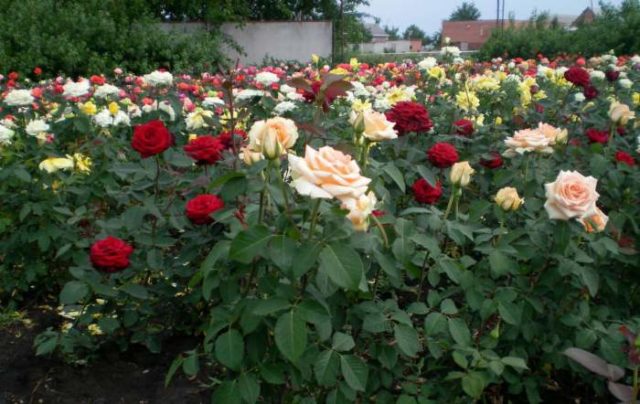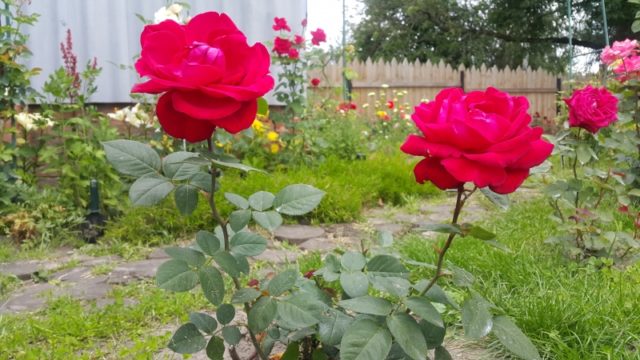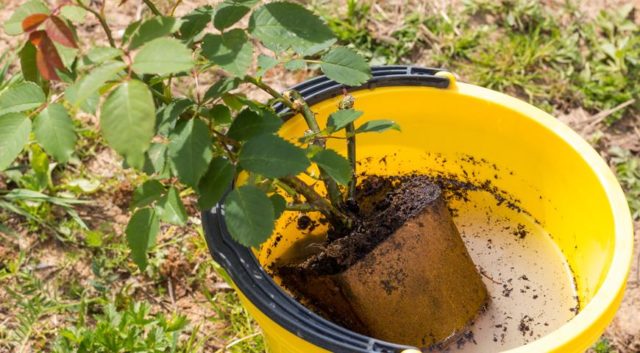Content
Transplanting roses to another place in the summer is well known to many gardeners. Although it is better to update the flower garden in the fall or spring, it often happens after hours. The gardener should know about the features of transplanting roses in the summer season, about its disadvantages and advantages.

Planting seedlings is best in spring or winter.
Is it possible to transplant roses in summer
Rose is an unpretentious plant and tolerates transplantation well. The operation can be performed at any warm season. Nevertheless, it is better to replant the rose in the spring, somewhere in the month of April, or already in the fall, in September-October. These are the most appropriate periods. If necessary, you can transplant roses in the summer. Each of these terms has its own characteristics and you need to know them.

Sometimes flowers have to be transplanted in the summer.
Why do you need a transplant
Roses in one area cannot grow for more than 10 years. The soil in this place, as well as inside the root lump, is completely depleted over time. Even the most abundant external feeding cannot correct the situation. Therefore, the only way out is to completely change the soil at the place where the roses grow or to transplant them to another area. Gardeners have long noticed that if young specimens are planted in the soil where roses have already grown until recently, they will not take root.

For a long time in one place, the flower will grow well and will not bloom
Disadvantages of transplanting bushes in summer
In the summer, you can also plant roses, but for this it is better to use container crops. Their root system remains intact, intact. They can be planted at any time, including in the summer. When transferring a bush from one place to another, the buds must be cut off before transplanting. This is the main disadvantage of the summer redevelopment of the flower garden.
If a rose bush is transplanted from one place to another, be sure to shade it. Roots damaged during transplantation will not be able to take root immediately and fully provide the plant with sufficient moisture on hot days. Therefore, the green leaves of a flower, as a rule, wither quickly, and its decorative properties decrease.

It is important to transplant the flower correctly at any time of the year.
How to transplant roses to another place in the summer
In the summer, roses are transplanted in the same way as in other times of the year. The algorithm of actions is approximately the same. The best option is if the growth conditions in the new location are identical to the previous ones.
Selection and preparation of a place, soil
The place must be chosen in light partial shade or created artificially. Newly planted roses do not like heat, drought very much, they can easily die if you do not create suitable conditions for them. For a transplant, it is better to choose a cloudy day so that the sun is not too hot, or do it in the late afternoon. Roses like loamy soil more, although they can be grown on any soil, with the exception of saline, marshy ones.
Before you start planting roses, you need to figure out what type of soil. An experienced gardener can do this by touch. Then add the missing elements to the soil and get an ideal substrate for roses. The soil should preferably be slightly acidic. If its composition is alkaline, add peat, which will acidify and improve the structure of the soil.The acidic environment must be alkalized with lime - 100 g per bucket of wet peat.

The ground around the seedling needs to be compacted
Seedling preparation
The most important thing is to carefully dig up the rose from the old place. Care must be taken not to damage the roots and earthy clod. But if this happens, then it is not critical. After 2-3 weeks, the roses will restore their root system completely. You should start by digging a rose bush in a circle, without getting too close to it. After that, you can carefully pry it off with a shovel. The taproot of the bush can be very long and its integrity has to be broken. It's not scary. The rose also has lateral processes that will develop quite well.

Planting a plant with a closed root system
Transplanting a rose to another place in the summer
The planting hole should be larger than the root system of the rose. The plant does not like stagnation of moisture. If the groundwater rises high, make good drainage. Prepare a fertile mixture: sand, peat and turf in approximately equal amounts. Fall asleep at the bottom of the pit, while forming a kind of mound.
Plant the seedling so that the root collar is level with the ground. But there are roses that have been grafted. In this case, the bush needs to be planted more deeply, more cover with earth. It is better to cut off all flowers and buds on the bush. It is necessary to give the plant the opportunity to spend energy not on the formation of an ovary or flowering, but on the formation of a good, powerful root system.
Then take a seedling and put it on the top of a mound, straightening the roots so that they do not bend up. Cover the space with good fertile and loose soil. Tamp the soil a little so that it surrounds the root system. To form a kind of irrigation hole: near the root collar there is a mound, and a little further along the circumference - a depression where water will accumulate.
After planting, water abundantly, sparing no water. This is necessary so that the ground tightly, from all sides encloses the roots, does not form air pockets around the seedling. After the water has been absorbed, sprinkle the hole with earth on top. Then it is advisable to mulch:
- straw;
- wood chips;
- peat;
- expanded clay (specially baked clay).
The moisture retention under the mulch layer is much higher. This is very important during dry periods of the year.

Mulching rose seedlings with peat
Follow-up care
After the transplant, proper care is crucial. For several weeks, the plant should be slightly covered from the sun, for example, by erecting a gauze frame on the side or something like that. If, during planting, the pits were filled with a fertile substrate, then in the near future no additional fertilizing is required. It is necessary to carry out regularly:
- clearing the land from weeds;
- loosening the earth;
- sufficient, but not excessive watering;
- mulching;
- sanitary pruning;
- preventive spraying against pests (aphids).
If the seedling is tall enough so that the wind does not twist it, it is advisable to tie it up. Stick a peg next to it and with special clamps, fix it with ropes. There must be a gap between the post and the plant. Roses love an abundance of light, they can grow in partial shade, but they will not have a lush bloom. Also, flowers are very afraid of drafts, strong winds. Therefore, the garden area must be well ventilated, but at the same time be securely fenced.

The top of the flower must be removed during transplantation.
How to transplant roses during flowering
When transplanting roses during flowering, you have to sacrifice all their beauty. Be sure to remove all newly formed or blossoming buds. This is necessary in order to save the plant's energy for rooting in a new place. You should also remove all weak, non-viable shoots, healthy ones - shorten. Remove the root system from the soil with the utmost care, taking care not to damage it.
Transplant by cuttings is carried out as follows:
- cut off the stalk, remove the lower leaves, leaving two buds;
- remove all unnecessary from above, including the flower or bud itself;
- dig a landing hole;
- stick the seedling into the ground at the bottom of the pit;
- pour water on;
- sprinkle, compact with earth;
- cover with a plastic bottle without a bottom;
- fall asleep;
- seal the earth around the can so that air does not enter.
If the days are hot, the cap on the bottle must be opened to allow air to enter. On cold days, on the contrary, cork.
In the retail network, you can buy roses for planting in bloom. When buying them, it is important to make sure that the plants grew in a pot and did not get into it from a flower bed for sale. It is necessary to carefully inspect the bottom of the container. If white young roots look out of the drainage holes, then you can buy such a seedling - it is grown in a pot. In the presence of old thick roots, it is necessary to conclude that the rose was dug out of the garden and put up for sale with chopped off shoots.
Conclusion
Transplanting roses to another place in the summer is not the most difficult task. The process will go well, provided that all the rules of planting and further care are followed.








